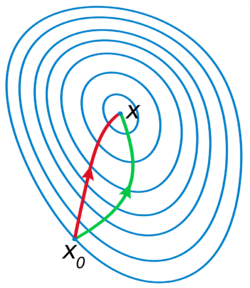🔬 Tutorial problems iota#
\(\iota\).1#
Find the largest domain \(S \subset \mathbb{R}^2\) on which
is concave.
How about strictly concave?
It is useful to review the Hessian based conditions for concavity and the conditions for definiteness of a Hessian of \(\mathbb{R}^2 \to \mathbb{R}\) functions.
⏱
\(\iota\).2#
Show that the function \(f(x) = - |x|\) from \(\mathbb{R}\) to \(\mathbb{R}\) is concave.
Because the function is not differentiable everywhere in its domain, using the definition of concavity could be an easier way.
⏱
\(\iota\).3#
Consider the function \(f\) from \(\mathbb{R}\) to \(\mathbb{R}\) defined by
Give a necessary and sufficient (if and only if) condition on \(c\) under which \(f\) has a unique minimizer.
⏱
\(\iota\).4#
Let \({\bf C}\) be an \(N \times K\) matrix, let \(z \in \mathbb{R}\) and consider the function \(f\) from \(\mathbb{R}^K\) to \(\mathbb{R}\) defined by
Show that \(f\) has a unique minimizer on \(\mathbb{R}^K\) if and only if \({\bf C}\) has linearly independent columns.
Obviously, you should draw intuition from the preceding question.
Also, what does linear independence of the columns of \({\bf C}\) say about the vector \({\bf C} {\bf x}\) for different choices of \({\bf x}\)?
⏱
\(\iota\).5#
Consider the maximization problem
subject to \(c_1 \geq 0\), \(c_2 \geq 0\) and \(p_1 c_1 + p_2 c_2 \leq m\). Here \(p_1, p_2\) and \(m\) are nonnegative constants, and \(\beta \in (0, 1)\).
Show that this problem has a solution if and only if \(p_1\) and \(p_2\) are both strictly positive.
Solve the problem by substitution and using the tangency (relative slope) condition. Discuss, which solution approach is easier.
To answer the first part of the question, review facts of existence of optima.
⏱
